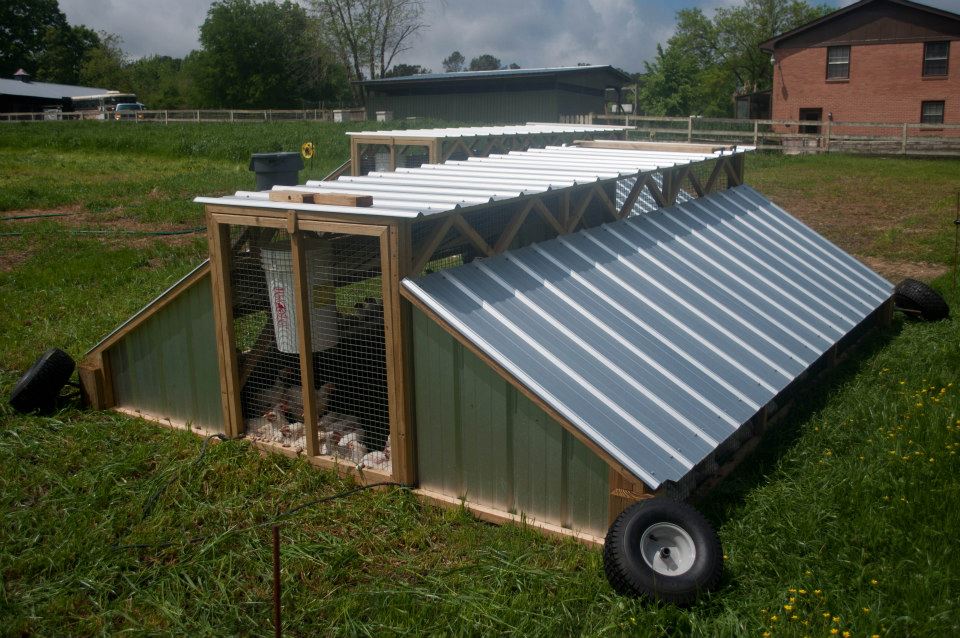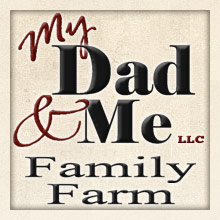The quest for a perfect chicken tractor, or floor-less, portable field shelter is a hard one. Depending on how many broilers you might raise, which breed, and how much land you’ve got are just the beginning of the requirements.
When we started raising broilers several years ago, we had a particular requirement that dictated the size of the pen. The broilers were just an experiment at first. We were growing raspberries in the front yard in 50′ rows with about 4′ feet of clearance between the plants, so we designed portable pens 42″ wide, 8′ long. We built four pens originally and as demand skyrocketed for the fresh chicken raised on pasture, we built six more two seasons later and moved them into the pasture behind the cows. The next year I toyed with a larger pen, this time 66″ wide, 8′ long, with a custom dolly to move the pen around. At this point, we were raising a lot of broilers each year, and moving 11 different pens for the number of birds we were able to raise was getting crazy!
So, nothing gets you going like necessity, right? The motivation for new pens came after losing a number of birds due to heat exhaustion in the 105 degree summer heat three years ago. The 24″ high portable pens that were only 42″ wide trapped too much heat in for the birds to handle. Immediately after that broiler season was over, we sold our 11 chicken tractors (with warnings about our problem) and set out to build new ones, needing them done by April 1st! We drew and we discussed and we drew and we discussed pros and cons time and time again. Our parameters were several:
We needed a pen that could shield the birds from the extreme heat, but could still protect the birds from cold in early April and late October. We also needed a much larger pen to consolidate and simplify our labor in the field. The only way to get the heat out began to dictate a higher and more complicated roof system. Then, the higher roof meant we could enter the pen to feed and water the birds rather than reach into the pen. This meant the pen got heavier and heavier, the usual death-knell to “new” chicken tractor designs. We didn’t like the idea of PCV because of the brittle issue over time. Galvanized conduit is lightweight, strong and cheap, but connectors are expensive and my dad & I are carpenters, not metal workers… I won’t continue to bore you with the endless ideas we tried, on paper, in actual prototypes, etc., but after working very hard to simplify, simplify, simplify, here’s the result!
There are two key features that make moving this big pen feasible. One are the large wheels. They cost a bit up front at nearly $50 dollars apiece, but I put the shaft onto each wheel and simply have a hole to seat the ‘axle’ on each tractor. The other feature is that I’ve learned to push these pens, as you’ll see in the video, rather than pull them. There are two problems with pulling portable pens: one, it’s easier to run over the chickens pulling than pushing. You can’t see the back wall of the tractor, and chickens don’t always move when they should! Second, pulling is more difficult (especially pulling and lifting) than simply pushing something at chest height.
The other design breakthrough is the carefully built truss. I can stand on the middle of the 12′ span and there’s very little deflection! But, the pens still move easily. We used 1″ welded wire on the pen as opposed to traditional chicken wire and this adds some structural strength as well as more protection against predators. A lot of people want “free-range” chicken and don’t understand how many animals think chicken is as delicious as we do! The pen is more for protecting the birds rather than limiting their access to the pasture. We solve the fresh pasture problem by moving these pens to fresh grass twice a day for 7-8 weeks (the first 2-3 weeks they are raised in a warm, protected brooder).
Rather than give you a written description of how I move this pen, which is much easier than it looks, Tina took a little video footage of me and Willie moving the last batch of Freedom Rangers last year. So check ’em out!
The waterer is a 4″ PCV pipe used as a reservoir, which is connected to a 1 1/2″ PVC pipe with nipple type drinkers for the chickens. We hung trough feeders, which allows me to just walk up to the pens, put on the wheels and move them, rather than have to pick up feeders, them move, then replace the feeders. Also, one feature that might not be apparent from the video is that I can move the pens sideways as well. The wheel blocks accommodate the axles in a total of 3 height positions to move forward, and 2 height positions to move sideways. This allows me to checkerboard around obstacles, and the pens can also move ‘backward’ the same as ‘forward’, so getting to the end of a field and heading the other way is simple. All in all we’ve used these tractors for two seasons and we love them! The birds appreciate the coolness of the design, I like the ease of moving them, and sometimes I just walk in, sit on a bucket, and watch the chickens enjoy the fresh air and sunshine!



This is fantastic! I appreciate all your effort to help grow healthy, happy (and delicious!) chicken!
I’m curious… I’m very interested in having my own laying hens (but would need to have them at my father-in-laws…my neighborhood doesn’t allow them). My question is, would a mobile tractor like this work for laying hens? I’m guessing we’d only need 2-4 for our family of 4? Also, could you have broilers and laying hens in the same tractor? I’d want to have them in a mobile tractor to be sure they’re getting fresh area, while protecting them from predators.
Finally, could your building plans for this pen be adjusted for the smaller number of chickens I would have? And, how many chickens could I have in a small back yard (60’x60′)?
Thanks for being willing to answer this chicken dreamer’s questions!!
Hi Amy, I’m glad you enjoyed the post. A mobile tractor works great for laying hens, although you need a place to house them in the winter (when no grass is growing to rotate them around the yard/pasture). The broilers obviously don’t need winter housing… Figure 50% on the eggs you can expect each day, per number of hens, on average. When they first start laying, four hens might give you four eggs for a little while, but over their life span, it’s more like one egg every two days. And keep in mind that you will generally lose a chick or two from the hatchery as you raise them, and a hawk or some predator inevitably gets one or two after they’re laying, so try to raise at least a dozen hens to be sure you have enough eggs. You could easily keep 10-20 chickens in a 60×60, more if you worked it carefully and had a winter house solution. You can also add a garden area into the mix for the chickens; they fertilize and eat weed seed whenever you’re not growing something. Catch us on the back porch sometime and we’ll be glad to answer any more questions you might have!
SOOO interesting! And that Willie is the cutest! Got a good chuckle at him in the video! He is really learning the family farm way! You are raising hin RIGHT! I am also very grateful for you guys so very much! All that you do and how you do it so that we can enjoy the fruits of your hard work. I am still so impressed with how CLEAN you keep everything! Enjoying all the milk, Pepitas, cheese, veggies, chicken, etc., etc., etc. that you prepare! Also the interesting woodworking! God bless you all!
Great video! Willie is learning from the ground up to do everything. David, you are forever creating something, so nice to see the fruits of your labor(fun). How about pictures of this big table you are making! Sounds like it is very attractive.
That was a fun video!